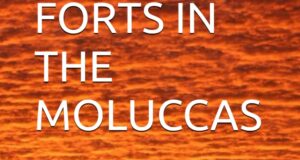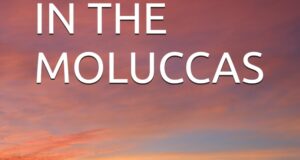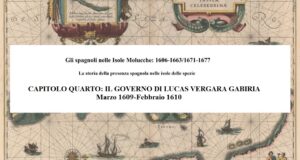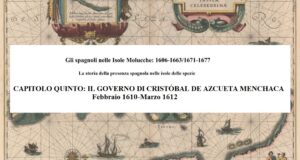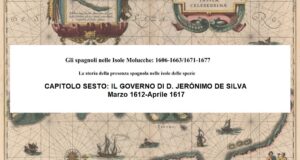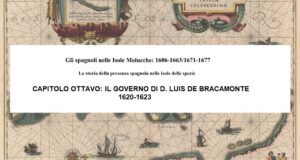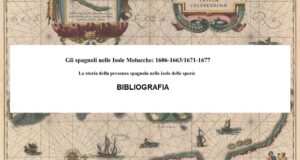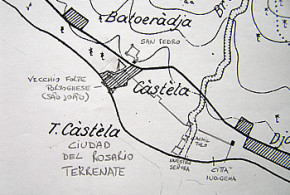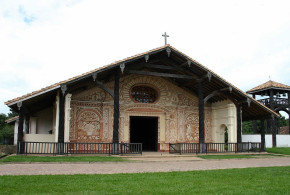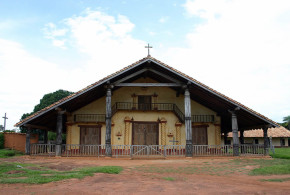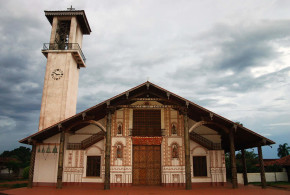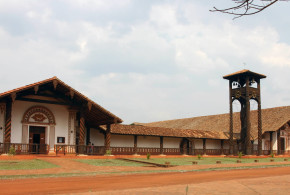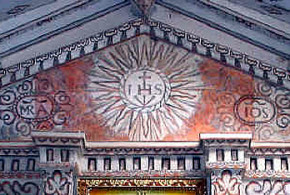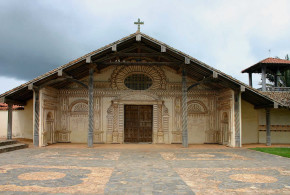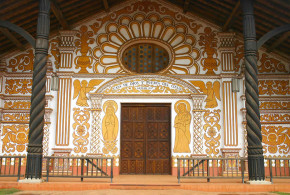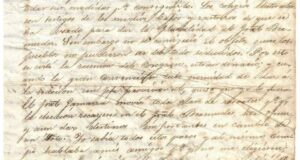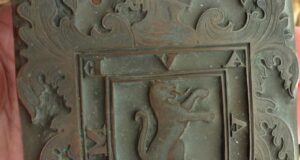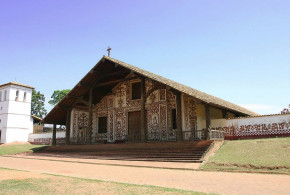This post is also available in:
![]() Italiano
Italiano
Written by Marco Ramerini 2000-2007/2023
6 – WEST COAST AND NORTH COAST OF THE ISLAND
On the western coast of Tidore the Spanish had garrisons in the localities of Marieco, Rume, Tomañira (which was almost certainly the same fort sometimes also called Marieco el Chico) and finally in the extreme northern tip at Chobo. This part of the island which faces the south coast of the island of Ternate and the island of Maitara was the area of Tidore richest in clove plants, its possession allowed the control of the passage of ships on the channel between Tidore and Ternate, which was mainly controlled by the forts of Rume and Chobo. Also along this coast the Dutch maintained, for less than 10 years, their only outpost on the island, the fort of Marieko.
6.1 – MARIECO
Marieco, Marieko, Marisco, Mariaco, Maxico el Grande1: (Current name: Mareko o Mareku)
CHRONOLOGY: Spanish: 1609 – 8 or 9 February 1613
Dutch: 8 or 9 February 1613-1621/22
Reoccupied by the Spanish in 1621/22-c.1646
According to tradition, Marieco was the village where the first kings of Tidore had originated. The village was originally located on the slopes of the mountain, then later it was moved to the coast due to the development of the clove trade.2
According to de Clerq, Marieco consisted of two villages called respectively Mariku Loah Ho (Upper Mariku) and Mariku Loah Isa (Lower Mariku) strangely the village called Mariku Loah Ho (Upper Mariku) was located on the beach while Mariku Loah Isa (Lower Mariku) was located on a hill. De Clerq also explains the reason for this strangeness, the names, high and low, indicated the position of the two villages towards the north, which was the typical way of orienting the Moluccas. So the village Mariku Loah Isa (Lower Mariku) was the one located further south (albeit on a hill) and Mariku Loah Ho (Upper Mariku) was instead the one located further north.3
From this description it seems possible to identify the village of Marieco called Mariku Loah Ho (Upper Marieco) in the Marieco el Grande conquered by the Dutch in February 1613, it was in fact the village located north along the beach. While Mariku Loah Isa (Lower Marieco) is probably Tomañira (or Marieco el Chico) of the Spanish, located on a hill south of the other Marieco. Formerly Marieko was the main village and capital of the island of Tidore, then it seems as early as the arrival of the first Europeans, the capital was moved to Soa Siu, better positioned to trade with the newcomers.4
The first sources that mention Marieco are the Portuguese historians Fernão Lopes de Castanheda and Gaspar Correa. The village of Marieco (called Mariaco), is described by Castanheda as the ‘lugar principal‘ of the island of Tidore. A very large place, located on a mountain almost in the middle of the island, a place where the kings of Tidore once resided. This was before the city by the sea was populated, which at the time of Castanheda had become the main settlement of the king of Tidore.
Marieco was surrounded by ‘tranqueiras‘ on one side while on the other sides there were ‘algûa caua‘ (probably = precipitous rock walls or caves?), this position contributed to making it a difficult place to conquer. It was attacked several times by the Portuguese.5 Gaspar Correa also tells us the same story about the village of Marieco: ‘hum lugar que estaua em huma serra, que soya a aposento dos Reys de Tidore, que depois se passarão abaixo á fralda do mar, por caso do trato dos mercadores; o qual lugar era cerquado de tranqueiras de páos com algumas entradas, com que estaua forte.’ After an unsuccessful attempt, the Portuguese managed to capture Marieco in 1524. The captain of the Ternate fortress Antonio de Brito, saw from the fortress the fire caused by the looting of the Portuguese soldiers (‘Antonio de Brito da fortaleza bem vio o fogo no lugar, que era a vista…’).6 Marieco (called in the document ‘Mariecu‘), is mentioned around 1528 by the Spaniards as a place on the island of Tidore which was located in front of Ternate.7
In 1609, a Dutch document describes Marieco as the second most important city of the island of Tidore after the capital, in Marieco there was also a pier for the galleys.8
The first news of a Spanish fort in Marieco comes to us in 1609, when the governor of Ternate Lucas de Vergara Gaviria fortified the place of Marieco on the island of Tidore ‘… hiço de nuebo los fuertes de Marieco …’. The usefulness of this fortification was tested shortly after its construction when, between the month of November 1609 and January 1610, the fleet commanded by Simon Jansz Hoen attempted to besiege the island of Tidore, on this occasion a naval blockade was also made at the fort of Marieco whose defense was attended by the company of Captain Pedro Zapata which included the soldier Juan de Medina Bermudez.
On this occasion, the ship ‘Middelburgh‘ commanded by Commander Crackeel was in charge of checking and preventing supplies to the fort of Marieco. Evidently the Dutch did not succeed in their plans, because Juan Martin de Liedena who was captain of the ‘capitana‘ galley ‘San Xptoual‘ (he served in this position from 1 August 1609 until 30 January 1610), brought large quantities of weapons, ammunition, soldiers and supplies to the Spanish garrisons, especially Marieco, which were besieged by the Dutch.9
Further confirmation of the existence, in this period, of the fort of Marieco is a letter from 1610 in which Paulus van Caerden informed the administrators of the VOC of the limited knowledge that the Dutch had of the island of Tidore, in particular they had no information of the defenses of the capital of the island, while they were informed of the existence of a fort in Marieco.10
Another Dutch report written in 1610 gives us a description of the small village of Marieco, which is located opposite the Spanish city of ‘Nuestra Signora del Rosario‘ of Ternate, some Tidorese lived here and the Spaniards had surrounded the place with two bastions, where 14 Spanish soldiers and two cannons were stationed.11
In fact, the Spanish built this small fort (‘fortezinho‘), located on the west coast of the island of Tidore and in front of the Spanish city of Ternate, directly at the level of the beach, it must have been a small thing, a simple wall with one or two bastions, probably not even completely of stone. According to some testimonies, its normal garrison consisted of 12 soldiers and an ensign, ‘fortezuelo de fajina con doce españoles y un cabo‘, the fort appears to have been armed with two cannons.12
The objective of the Spaniards was to control with the small garrison a vital area for the sustenance of their garrisons and to be able to control the transit between the islands of Ternate and Tidore, the low number of soldiers who garrisoned the place was perhaps due to the excessive confidence that the Spaniards had in the help of the troops of the local ‘sangaje‘, as well as obviously the scarcity of troops at their disposal, something the governors of Ternate always complained about. It was precisely the betrayal of the local ‘sangaje‘ in addition to the excessive power of firepower fielded by the Dutch and the inactivity of the governor de Silva and the king of Tidore that allowed the Dutch to conquer the fort in February 1613.
THE DUTCH CONQUEST OF MARIEKO
In the first days of February 1613, 5 Dutch ships (4 warships and 1 cargo ship) arrived in the Moluccas, one of these was shipwrecked due to bad weather between the islands of Maquien and Motiel, according to da Silva, this was the ‘captain‘ ship which had 300 men and 45 artillery pieces on board as well as most of the money for the garrisons, only 40 men were saved from the sinking.
The other ships of the fleet arrived in Ternate. At midnight on February 8, 1613, 5 Dutch ships, commanded by Pieter Both, 7 ‘caracoas‘ and many other small boats, carrying more than 800 men, both European and indigenous, headed for the island of Tidore, where they anchored off to the village of Marieco and the small garrison that the Spaniards had there, which was defended by only 12 Spanish soldiers and an ensign ‘fortezuelo de fajina con doce españoles y un cabo’. According to Gerónimo de Silva, the Dutch attack on Marieco took place on February 9, 1613 “á el cuarto del alba” time when the Dutch began shelling the blockhouse so intensely, “mas de 160 balas”, so as to level all the embankments and part of the wall of the small fortification.
The Spanish troops led by the ensign Juan Centeno did not surrender, but fought to the death, and in the battle practically all the small Spanish garrison of the fort was killed (12 Spaniards and 12 Pampamgos according to Pérez who quotes Fr. Gregorio de S. Esteban13), only the gunner was taken prisoner and taken to the fortress of Malayo.
The Dutch, who according to the testimony of Gerónimo de Silva, had attacked the small fort with 500 Dutch soldiers and more than 300 Ternatese, lost in the battle 6 soldiers, a captain of a ship and the lieutenant of the fort of Malayo as well as 12 men seriously wounded. In this episode de Silva’s letters highlight the cowardice of the natives, in fact they all fled abandoning the Spaniards during the attack so that only one of them, called Rubaongue, fought until his death. After three hours of battle, the victors set fire to the village, fearing the arrival of the Spanish and Tidorese, and then began to rebuild the fort.14
According to what Gerónimo de Silva tells us, the behavior of the few Spanish soldiers garrisoning the fort was exemplary, ‘… no habia mas de 12 españoles y uno ó dos piececitas …’, 15 while he defines ‘grandes bellacos’ that is, great cowards the Tidorese who were defending the village who passed over to the enemy ‘… se debiera consolar por haber perdido tan grandes bellacos indios como allí estaban y dignos de castigo.’ The Dutch capture of the fort had been favored by the behavior of the ‘sanjaje‘ of Marieco, who was in league with the Dutch with whom he traded and that the day before the Dutch attack he had shipped his wife and much of his property. Confirming the fact that he was in league with the Dutch is the testimony cited by de Silva that before leaving, the wife of the ‘sangaje‘ had advised the ensign Juan Centeno, head of the garrison, to stay awake at night and not sleep during the day. In addition to the betrayal of the ‘sangaje‘ de Silva also complained of the fact that the Tidorese had always prevented him from adequately fortifying that port.16 This relationship of mutual distrust between the two allies often comes to light in Spanish documents and will be the cause of major problems and misunderstandings between the Tidorese and the Spanish.
The Dutch immediately after their victory began to rebuild the fort, they built a new fort whose structure was formed by 4 bastions and placed two garrison companies there, already at the departure of Both, in March 1613, one of the bastions had been finished. Both describes Marieco as the richest place in all of Tidore Island, where the best quality of cloves was produced and from where the Spaniards of Ternate received wool, fruit and fish for their garrisons, the loss of Marieco had been according to the Dutch admiral a heavy blow to the Spanish who now found themselves deprived of their main source of food as well as the only clove-producing area which until then had remained under Spanish control.17 Furthermore, the possession of Marieco allowed the Dutch to control the stretch of sea immediately in front of the main Spanish city of ‘Nuestra Señora del Rosario di Terrenate‘, the fort also served as a base for the company’s ships waiting for the arrival of Spanish relief from Manila, whose capture was a constant nightmare for the Spanish, who had their only chance of survival in this tenuous link with Manila.
According to the sketch of an anonymous Dutch soldier the fort that the Dutch built was square in shape and with 4 bastions on the sides. The entrance gate was positioned in the center of the wall that joined the two bastions located on the sea side, between the gate and the coast there was a small indigenous village.18 The Dutch called the new fort of Marieco (Marieecke), ‘de Vereenichde Provintien‘, the 4 bulwarks were baptized: ‘Uutrecht‘, ‘Enckhuysen‘, ‘Amersfort‘ and ‘Reaell‘.19
Another interesting representation of this fort is present in the French National Library in Paris cataloged with the number 6545 of the “Gaignieres Collection” in this image entitled “T’fort Mariecco op t’eylant Tidore” there is a schematic plan of the fort and a very detailed “bird’s eye” view. In it the fort is represented in a square shape and with 4 bastions at the corners, 4 pieces of artillery were mounted on each bastion, to reach the ramparts from inside the fort, wooden stairs were positioned as the ramparts were raised with respect to the internal floor of the fort.
Inside the fort there were several buildings, probably the accommodation for troops and warehouses. The entrance to the fort was positioned in the center of the wall which overlooked the sea and between the fort and the sea on this side there was a village with cultivated gardens and several huts, the whole village was surrounded on three sides by a wooden palisade which it connected on both sides to the ramparts of the fort.20 The Dutch fort of Marieco was garrisoned by a garrison made up of a captain and 60 soldiers and had 17 artillery pieces on its ramparts including a very large one called ‘o Raymundo‘. The quantity of artillery and the number of soldiers garrisoning the Dutch forts was generally always much higher than that available to the Spanish. Around the fort (‘a roda del forte‘), there was a wooden palisade inside which were the homes of the soldiers and the natives. The Spanish had their own fortress (Tomanira) near this Dutch fort and due to the proximity between the two forts skirmishes between the two garrisons were frequent.21
Despite the advantages that the occupation of this fort brought to the Dutch and the problems it created in opposition to the Spanish, the duration of the Dutch occupation of Marieco was short, in fact, following an order from Coen in June 1621, the Dutch dismantled and abandoned the fort of Marieko. In confirmation of this, in July 1621, the king of Tidore wrote in a letter to Alonso Serrano, who was in charge of the garrison of Payaje, that he had received news that the Dutch were intending to withdraw from the forts of Calomata and Marieco. The Spaniards promptly rebuilt the fortifications and posted a garrison there. The dates of the abandonment of Marieko by the Dutch and the occupation of the fort by the Spanish are to be placed between the end of 1621 and the beginning of 1622.22
The causes of the abandonment of the fort by the Dutch are probably to be found in the excessive costs of maintaining such a large garrison in a generally hostile territory and in the continuous and incessant attacks that the Spaniards from their forts of Rume and Tomanira regularly carried out at Marieco to prevent them from picking cloves and which practically confined the garrison of Marieco closed inside the fort. Furthermore, last but not least, the Spaniards, as well as in Tidore, had intensified their disturbance operations also on the island of Ternate where the chronicles tell of frequent clashes along the border, especially in the immediate vicinity of the new Dutch fort of Calomata. All these factors convinced the Dutch to concentrate their forces on the garrisons they deemed most important.
There is not much information regarding the subsequent Spanish occupation of the place, but to confirm it, Marieco is mentioned among the Spanish forts in “Livro das plataforma das fortalezas da India”: ‘…na ponta do Mariaco em Tidore temos outra fortaleza: è a fortaleza que está na ponta do Mariaco, defronte de Tarnate…’23 However, the few documents that speak of Marieco in the following years suggest that the presence of a Spanish garrison and fortification in the village continued until at least 1646. In fact, in that year, Juan Camacho de la Peña, who was the head of the galleys of Ternate, helped with the galleys the ‘socorro‘ that came from Manila to defend themselves from a Dutch galleon and subsequently having received certain news that the Dutch intended to take over the fort of Marieco on the island of Tidore, with the 5 galleons that were anchored in Malayo, was sent to demolish and raze that fortification.24
Confirming that the fort was actually abandoned is that it is not listed among the forts garrisoned and dismantled in 1663, when all the Spanish garrisons were withdrawn from the Moluccas. Probably being the village still of a certain importance, it was garrisoned by Tidorese soldiers. In 1662, towards the end of the Spanish period in Tidore, the ‘sangaje‘ of the village of Marieco was considered the second most important figure in the hierarchy of the island after the king of Tidore.25
Not much remained of the fort in the 1920s, all that was visible was a pile of stones with remnants of masonry, and then a long part of a bulwark which was covered in sand and where two parapets were still recognizable.26 It seems that some blocks of stones believed to have belonged to the old fort are still visible among the vegetation of Marieco.27
| Captains of Marieco | |
| Juan de Astera 28, sergeant | ? – June 1611 |
| Hernando [Fernando] Xuarez (Suárez)29, ensign | June 1611- August 1611 |
| Juan de Salinas30, ensign | August 1611 – ? |
| Juan Centeno31, ensign | 1612 – February 1613 |
Occupied by the Dutch | February 1613 – end of 1621 or beginning of 1622 |
| Juan de Chaves32, captain | ? – June 1623 |
| Gaspar de Enebro33, captain | June 1623 – ? |
INDEX:
1 – The Spanish fortresses on the island of Tidore 1521-1663: introduction
3 – The Spanish expeditions to the Moluccas after the union with Portugal
4 – The Spanish forts of the island of Tidore 1606-1663
5 – The defenses of the city of the King of Tidore: Lugar Grande De El Rey (Soa Siu)
6 – Fuerte de los portugueses (Fortaleza dos Reis Magos)
7 – Tohula Fort, Santiago de los Caballeros
8 – Sokanora Fort
9 – Marieco Fort
10 – Tomanira Fort
11 – Chobo Fort
12 – Fort of Rume
13 – Puli Caballo Island
14 – Captains of Tidore (Fortress of Santiago de los Caballeros)
NOTES:
1 “Carta del Alférez Juan Centeno, cabo del presidio de Maxico el Grande, escrita al gobernador don Gerónimo de Silva. Maxico, de 20 de julio hoy viernes de 1612” in: Various authors “Correspondencia” 34
2 Andaya, L. “The world of Maluku” (Honolulu, 1993) 51.
3 De Clercq, F.S.A. “Bijdragen tot de kennis der Residentie Ternate” (1890, Leiden) 69 (In the English translation, pdf edition p. 46)
4 Valentijn, F. “Oud en nieuw Oost-Indiën” Vol. I (Dordrecht, Amsterdam 1724-1726) 160
5 Fernão Lopes de Castanheda “História do descobrimento e conquista da Índia pelos portugueses” Livro VI, cap. 64, 252-253
6 Correa “Lendas da India” vol. II, 806, 808
7 “Derrotero del viage y navegacion de la armada de Loaisa…” Document n°14 in: Martin Fernanadez de Navarrete “Colección de los viajes y descubrimientos que hicieron por mar los españoles, vol. 5” 306
Martin Fernanadez de Navarrete “Colección de los viajes y descubrimientos que hicieron por mar los españoles, vol. 2” 188-189
8 “Informatie van den stant van de Molucques, door Jan Bruyn, 12 may 1609” In: “De reis van de vloot van Pieter Willemsz Verhoeff naar Azie, 1607-1612” vol. II; 317
9 “Journael ende verhael” In: “De reis van de vloot van Pieter Willemsz Verhoeff naar Azie, 1607-1612” vol. I, 276-281; “Informaciones Lucas de Vergara Gaviria, 1611” AGI: Filipinas,60,N.12; Tiele “De Europeers in den Maleischen archipel, 1606-1610” 102-103 footnote 3 where reference is made to a letter written from Mariequo on Tidore: “Brief van C. Lz. Crackeel (schipper op de Middelburg) voor Mariequo op Tidore, aan Hoen van 3 Jan. 1610”; “Confirmación de encomienda de Guisan, etc. Expediente de confirmación de las encomiendas de Guisan, Lantac, Adpili, Panglao, Masago, Panaon y Ormoc en Cebu en Leyte a Juan de Medina Bermudez. Resuelto, [f] 12-08-1633” AGI: Filipinas,48,N.67; “Confirmación de encomienda de Cuyo. Expediente de confirmación de la encomienda de Cuyo en Calamianes a Juan Martínez de Liedena. Resuelto, [f] 10-02-1623” AGI: Filipinas,47,N.47
10 de Booy “De derde reis van de VOC naar Oost-Indië onder het beleid van admiraal Paulus van Caerden uitgezeild in 1606” vol. II, 239 “Copie van het scrijven van Paulus van Caerden aan de bewindhebbers dd. 17 juni 1610”
11 “Voyage of Admiral Pieter W. Verhoeven, 1610” 112
12 “Carta dirijida á S. M. por don Gerónimo de Silva, Terrenate” in: Various authors “Correspondencia” 121; “Memorial Grau y Montfalcon, 1637” In: Blair, E. H. e Robertson, J. A. “The Philippine Islands, 1493-1898” vol. 27, 105; “Fr. João Baptista, visitator, to Fr. Claudio Acquaviva, General. Ternate, 14 marzo 1613” Doc. n° 64 in: Jacobs, “Documenta Malucensia III, 1606-1682” 246 e nota 22; Van de Wall Van de Wall, V. I. “De Nederlandsche oudheden in de Molukken” 269
13 Pérez, Lorenzo O.F.M. “Historia de las misiones de los Franciscanos en las islas Malucas y Célebes” In: “Archivum Franciscanum Historicum” VII (1914) 221
14 “Carta que escribió á el rey de Tidore el gobernador don Gerónimo de Silva, Ternate, 14 de febrero 1613” e “Carta que escribió el señor don Gerónimo de Silva al señor don Juan de Silva” “Carta dirijida á S. M. por don Gerónimo de Silva, desde Terrenate, dandole cuenta del estado de las islas” In: Various authors “Correspondencia” 88-89, 95-98, 121-122
15 “Carta que escribió á el rey de Tidore el gobernador don Gerónimo de Silva, Terrenate, 14 febrero de 1613” in: Various authors “Correspondencia” 89
16 “Traslado de la carta que escribió el gobernador don Gerónimo de Silva á el rey de Tidore, Terrenate, febrero 10 de 1613” in: Various authors “Correspondencia” 84-85
17 Rietbergen, P.J.A.N. “De eerste landvoogd Pieter Both, 1568-1615” Vol. II, “Brief 15”, 275-276
18 See the interesting anonymous drawing of the west coast of Tidore, undated but probably done around c.1620: “Tidor en Mitarra, 2 kleine eil. Ten Z. van Ternate, ten W. van Gilolo op Halmahera” Preserved in the University Library of Leiden, the Netherlands: “Collectie Bodel Nÿenhuis” P. 314-I-n° 99
My thanks to Walter Hellebrand for alerting me to the existence of this important document.
19 Various authors “Generale Missiven, I” 35
20 Anonymous “T’fort Mariecco op t’eylant Tidore” Preserved in the French National Library, Paris: “Collection Gaignieres” 6545
21 Blair, E. H. e Robertson, J. A “The Philippine Islands, 1493-1898” vol. 27, 104-109; Various authors “Doc. Ultram. Portuguesa” vol. II, “Relaicon de las fortaleças y factorias que tienen los olandeses en la India y ingleses” 269-270; Various authors “Doc. Ultramarina Portuguesa” vol. I, “Relação breve da ilha de Ternate, Tydore…. Malaca, 28 novembre 1619”167
22 “Instructie voor F. Houtman, gegeven te Ambon, 11 Juni 1621”; Tiele, P.A. “De Europeans in the Malayan Archipelago, 1618-1623” 272-273; Pérez, L. “Historia de las misiones de los Franciscanos en las islas Malucas y Célebes” In: “Archivum Franciscanum Historicum” n° VII (1914) 622 che cita: Fr. Gregorio de S. Esteban “Historia de las Islas Malucas” 133; “Confirmación de encomienda de Santa Catalina. Expediente de confirmación de las encomiendas de Santa Catalina a Alonso Serrano. Resuelto. [f] 19-09-1638” AGI: Filipinas,49,N.25
23 Various authors “Livro das plataforma das fortalezas da India, 1620-1640”
24 “Confirmación de encomienda de Bagatayan, etc. Expediente de confirmación de las encomiendas de Bagatayan, Pajo y Liloan en Cebu, Bislig y Catel en Caraga a Juan Camacho de la Peña. Resuelto. [f] 09-10-1653” AGI: Filipinas,50,N.40
25 Andaya, L. “The world of Maluku” 71.
26 Van de Wall “De Nederlandsche oudheden in de Molukken” 269
27 See photos in: Various authors “Spain and the Moluccas. Galleons around the world” (Jakarta, 1992) 59
28 Sergeant Juan de Astera was head of the fort of Marieco, however he was then entrusted with the command of the fort of Payahe, in his place, on June 16, 1611, the ensign Hernando [Fernando] Xuarez (Suárez) was appointed superior head of the fort of Marieco. “Confirmación de encomienda de Masbate. Expediente de confirmación de la encomienda de la isla de Masbate en Ibalon (Albay) a Fernando [Hernando] Suárez. Resuelto, [f] 22-11-1623” AGI: Filipinas,47,N.65
29 The ensign Hernando (Fernando) Suárez on June 16, 1611, by order of Azcueta was sent to Tidore as head of the garrison of Marieco to replace the sergeant Juan de Astera, who was sent in charge of the fort of Payahe. On August 1, 1611 he was replaced in command of Marieco by the ensign Juan de Salinas.
“Confirmación de encomienda de Masbate. Expediente de confirmación de la encomienda de la isla de Masbate en Ibalon (Albay) a Fernando [Hernando] Suárez. Resuelto, [f] 22-11-1623” AGI: Filipinas,47,N.65
30 Head of Marieco starting from August 1611. “Confirmación de encomienda de Masbate. Expediente de confirmación de la encomienda de la isla de Masbate en Ibalon (Albay) a Fernando [Hernando] Suárez. Resuelto, [f] 22-11-1623” AGI: Filipinas,47,N.65
31 In July 1612 the ensign Juan Centeno was head of the garrison of Maxico el Grande “Carta del alférez Juan Centeno, cabo del presidio de Maxico el Grande, escrita al gobernador don Gerónimo de Silva, Maxico, 20 luglio 1612” In: Various authors ‘Correspondencia’ 34. Centeno was the ensign in charge of Marieco when the Dutch attacked the fort in February 1613, all the defenders, including Centeno were killed in the battle (12 men in total) only the gunner was saved who was captured by the Dutch. “Traslado de la carta que escribió el gobernador don Gerónimo de Silva á el Rey de Tidore, sobre la pérdida del puerto de Marieco, Terrenate, 10 febbraio 1613” In: Various authors ‘Correspondencia’ 84-86.
32 Juan de Chaves, was in charge of the forts of Xilolo, Marieco and Tidore (these before April 1623). Juan de Chaves, Bracamonte tells us, always had a good relationship with the king and prince of Tidore. He probably served in 1619 as the head of the Tomanira fort. He had been made captain by Lucas de Vergara Gaviria, June 27, 1617, and governed his own company until he was succeeded by Master Sergeant Pedro de Cuenca Montalbo, then later Juan de Chaves returned to command his company where he served for more than 5 years. In these five years he was in charge of the forts of San Pedro y San Pablo and Santa Lucia, Xilolo (Hilolo), Tomanira (Tomanera), Marieco (Merieco) and Tidore (‘Santiago de los Caualleros en la ysla de Tidore‘) in addition, due to the absence of the governor, was charged with the city of Ternate. In a summary (see sheet 38) it is said that he was also responsible for the Rume fort. He was head of the fort of Marieco, a position he held until June 1623. In fact, there is an order from Heredia (dated 5 June 1623) in which Chaves is commanded to give the captain don Gaspar de Enebro the command of the “fuerza de Marieco” together with the ammunition, artillery and infantry which were in his charge. Chaves had been licensed to go to Manila due to his failing health. “Confirmación de encomienda de Caraga. Expediente de confirmación de la encomienda de Caraga a Juan de Chaves. Resuelto, [f] 14-02-1631” AGI: Filipinas,48,N.49
33 There is an order from Heredia (dated June 5, 1623) in which Juan de Chaves is commanded to pass the command of the “fuerza de Marieco” to the captain don Gaspar de Enebro together with the ammunition, artillery and infantry that were in his charge. “Confirmación de encomienda de Caraga. Expediente de confirmación de la encomienda de Caraga a Juan de Chaves. Resuelto, [f] 14-02-1631” AGI: Filipinas,48,N.49
This post is also available in:
![]() Italiano
Italiano
 Colonial Voyage The website dedicated to the Colonial History
Colonial Voyage The website dedicated to the Colonial History


